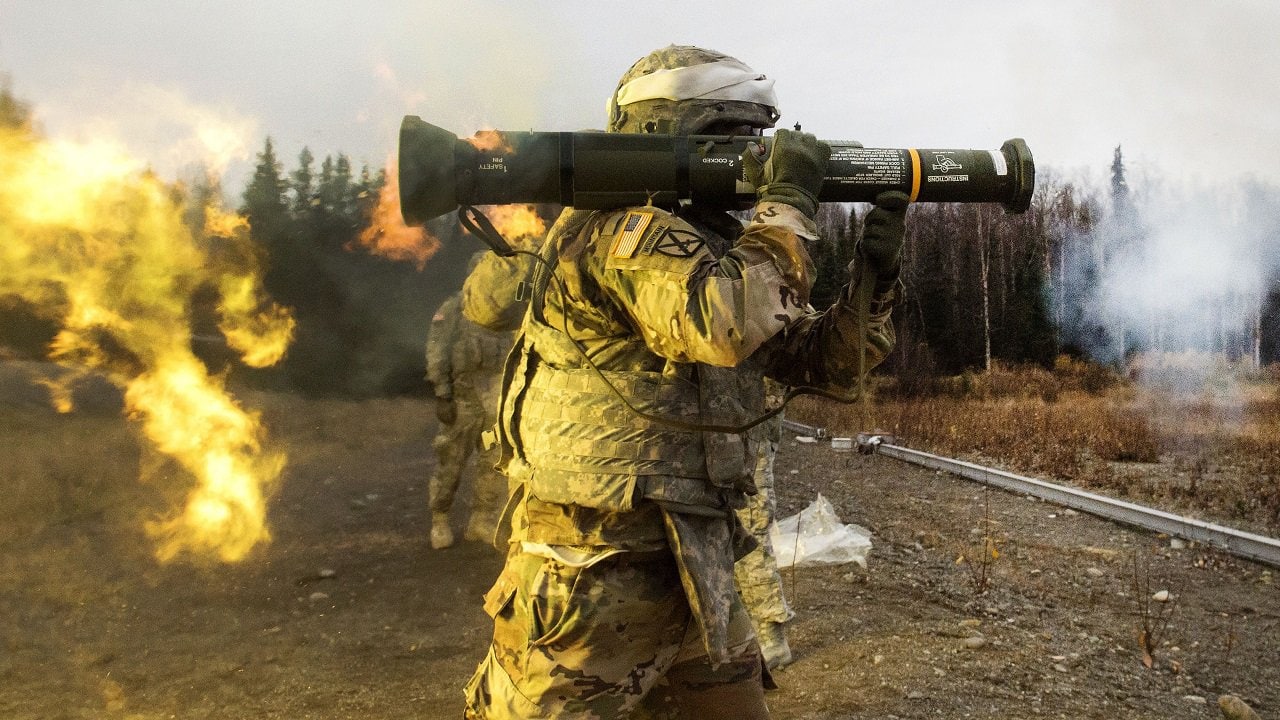One good article about Swedish-made antitank weapons kicking Russian armored ass(ets) in Ukraine deserves another…and another.
After having now penned two separate articles on the Carl Gustaf 84mm recoilless rifle, now it’s time to talk about another weapons system from the same manufacturer — Saab Bofors Dynamics, best known to WWII buffs for their iconic Bofors 40mm antiaircraft gun of WWII – that’s also proving itself to be a major pain to the tank forces Russia’s “special military operation” in Ukraine: the 84mm AT4 antitank weapon.
AT4 Early History and Specifications
The AT4 is a disposable – akin to the M72 LAW rocket in that regard – man-portable, shoulder-fired recoilless gun.
It’s neither fish nor fowl; not considered a rocket launcher because the explosive warhead isn’t driven by a rocket motor, and not a recoilless rifle per se because the inside of the barrel is a smoothbore.
Vital stats, courtesy of my 19FortyFive colleague Brent M. Eastwood, are as follows:
“The AT4 is a little over three feet long. It weighs around 15 pounds. The round can travel 820 feet in one second. The AT4 can penetrate 16-inches of armor. The maximum effective range is about 1,000 feet. The projectiles can be high-explosive anti-tank, dual-purpose delayed penetration, high-penetration, and anti-structure for urban combat.”
The weapon received its moniker as a double word play: (1) first of all on the 84mm caliber of the weapon (“eighty-four” to “AT4,” get it?); and (2) a play on the “AT” abbreviation for “antitank.” The first prototypes of the AT4 were tested in the spring of 1981, and entered into operational service with both the Swedish Army and the U.S. Army in circa 1987, with the former dubbing it as the Pansarskott m/86 (Pskott m/86) and the latter designating it the Lightweight Multipurpose Weapon M136 (and replacing the aforementioned LAW rocket in the process).
In addition to these two countries, at least 25 other nations’ military forces have adopted it, including Iraq, Ireland, Argentina…and now Ukraine (more on this shortly). The U.S. Army first used it in combat in Panama in December 1989 during Operation Just Cause, the mission to overthrow strongman Manuel Noriega; from there, American combat troops used the weapon in the Persian Gulf War AKA Operation Desert Storm, Operation Enduring Freedom in Afghanistan, and Operation Iraqi Freedom.
Over 600,000 AT4s have been built thus far.
Compared with the Carl Gustaf?
The AT4 is meant for use by an individual soldier and, as indicated by the use of the word “disposable” earlier in this article, is meant to be discarded after a single firing.
By contrast, the m/48 Carl Gustaf, though of the same caliber and weight as the AT4, is intended for two-person operation, i.e., gunner and loader, which allows for a rate of fire of 6 rounds per minute, though the Gustaf can also be used by a single operator in a pinch, with a concurrent reduction in the rate of fire.
The multi-use Gustaf bears a unit cost of $20,000 USD, whilst the single-use AT4 rings up a comparatively dirt-cheap unit cost of $1,480.64 USD.
AT4s = Avenging Angels for Ukraine
Back in early July 2022, my 19FortyFive colleague Peter Suciu wrote an article describing the Swedish government’s decision to send a weaponry package to Ukraine “valued at around 500 million Swedish crowns ($49 million).”
That package deal includes 5,000 AT4s, which tacks on to the 10,000 units of this same weapon system previously supplied by the Swedes **and** the additional 6,000 of them that the Biden Administration earmarked for shipment to Ukraine back in March 2022.
Now, as Mr. Eastwood reminds us, the AT4 is not quite as effective against main battle tanks (MBTs) – the NLAW and the Javelin are both better suited to that task – but still has plenty of utility against armored personnel carriers (APCs), plus enemy bunkers and defensive emplacements.
And even in the case of the MBTs, fire enough rounds at ’em, and the law of probability states that sooner or later, a lucky round will find a weak spot in the armor, as was demonstrated during WWII by the sheer number of M4 Sherman tanks that were ultimately available to prevail against the thick-skinned German Tiger tanks in spite of the former tank’s relatively weak 75mm main gun.
Not a pleasant thought for Mr. Putin and his generals to ponder.
Christian D. Orr is a former Air Force officer, Federal law enforcement officer, and private military contractor (with assignments worked in Iraq, the United Arab Emirates, Kosovo, Japan, Germany, and the Pentagon). Chris holds a B.A. in International Relations from the University of Southern California (USC) and an M.A. in Intelligence Studies (concentration in Terrorism Studies) from American Military University (AMU). He has also been published in The Daily Torch and The Journal of Intelligence and Cyber Security.

